fuel KIA OPTIMA 2020 Features and Functions Guide
[x] Cancel search | Manufacturer: KIA, Model Year: 2020, Model line: OPTIMA, Model: KIA OPTIMA 2020Pages: 591, PDF Size: 14.1 MB
Page 6 of 591
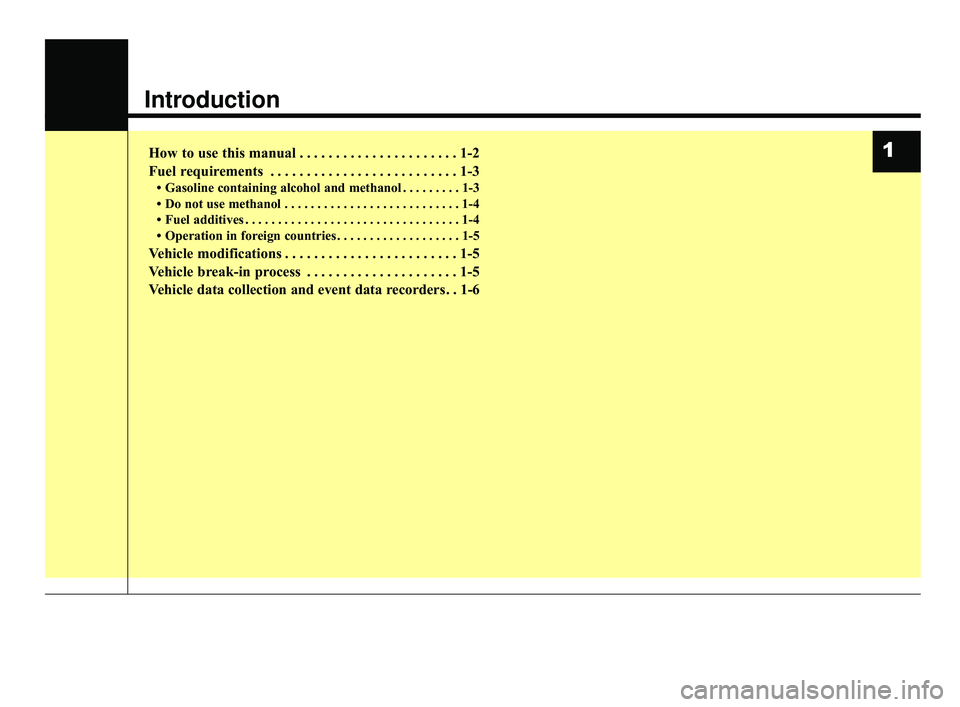
Introduction
How to use this manual . . . . . . . . . . . . . . . . . . . . . . 1-2
Fuel requirements . . . . . . . . . . . . . . . . . . . . . . . . . . 1-3
ŌĆó Gasoline containing alcohol and methanol . . . . . . . . . 1-3
ŌĆó Do not use methanol . . . . . . . . . . . . . . . . . . . . . . . . . . . 1-4
ŌĆó Fuel additives . . . . . . . . . . . . . . . . . . . . . . . . . . . . . . . . . 1-4
ŌĆó Operation in foreign countries . . . . . . . . . . . . . . . . . . . 1-5
Vehicle modifications . . . . . . . . . . . . . . . . . . . . . . . . 1-5
Vehicle break-in process . . . . . . . . . . . . . . . . . . . . . 1-5
Vehicle data collection and event data recorders. . 1-6
1
JFa PE USA 1.qxp 5/17/2019 4:47 PM Page 1
Page 8 of 591
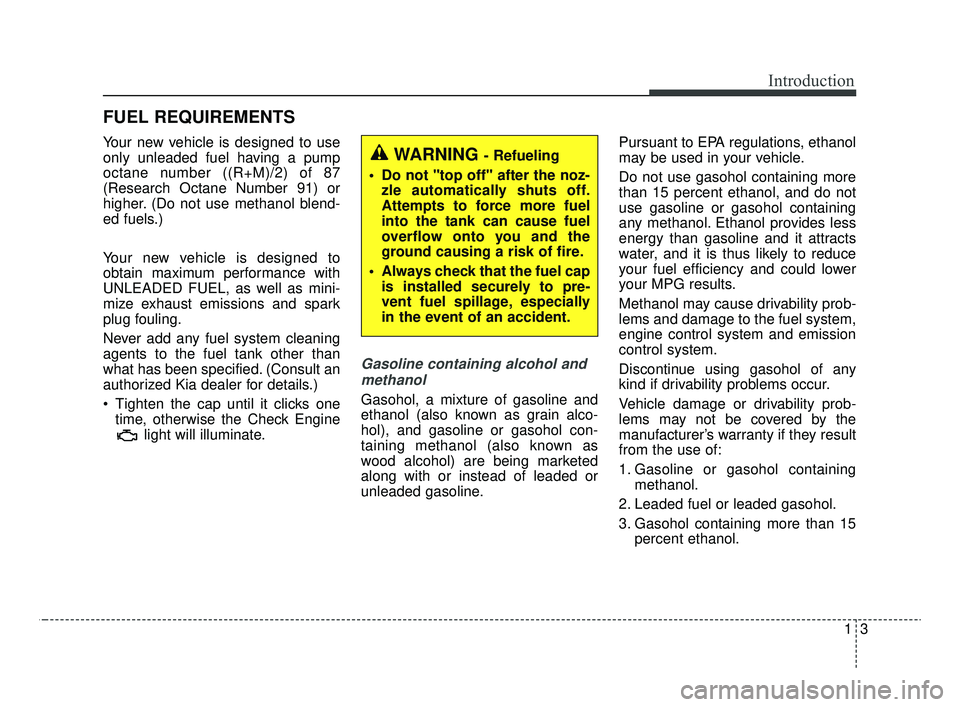
13
Introduction
Your new vehicle is designed to use
only unleaded fuel having a pump
octane number ((R+M)/2) of 87
(Research Octane Number 91) or
higher. (Do not use methanol blend-
ed fuels.)
Your new vehicle is designed to
obtain maximum performance with
UNLEADED FUEL, as well as mini-
mize exhaust emissions and spark
plug fouling.
Never add any fuel system cleaning
agents to the fuel tank other than
what has been specified. (Consult an
authorized Kia dealer for details.)
Tighten the cap until it clicks onetime, otherwise the Check Engine light will illuminate.
Gasoline containing alcohol and
methanol
Gasohol, a mixture of gasoline and
ethanol (also known as grain alco-
hol), and gasoline or gasohol con-
taining methanol (also known as
wood alcohol) are being marketed
along with or instead of leaded or
unleaded gasoline. Pursuant to EPA regulations, ethanol
may be used in your vehicle.
Do not use gasohol containing more
than 15 percent ethanol, and do not
use gasoline or gasohol containing
any methanol. Ethanol provides less
energy than gasoline and it attracts
water, and it is thus likely to reduce
your fuel efficiency and could lower
your MPG results.
Methanol may cause drivability prob-
lems and damage to the fuel system,
engine control system and emission
control system.
Discontinue using gasohol of any
kind if drivability problems occur.
Vehicle damage or drivability prob-
lems may not be covered by the
manufacturerŌĆÖs warranty if they result
from the use of:
1. Gasoline or gasohol containing
methanol.
2. Leaded fuel or leaded gasohol.
3. Gasohol containing more than 15 percent ethanol.
WARNING - Refueling
ŌĆó Do not "top off" after the noz- zle automatically shuts off.
Attempts to force more fuel
into the tank can cause fuel
overflow onto you and the
ground causing a risk of fire.
Always check that the fuel cap is installed securely to pre-
vent fuel spillage, especially
in the event of an accident.
FUEL REQUIREMENTS
JFa PE USA 1.qxp 5/17/2019 4:47 PM Page 3
Page 9 of 591
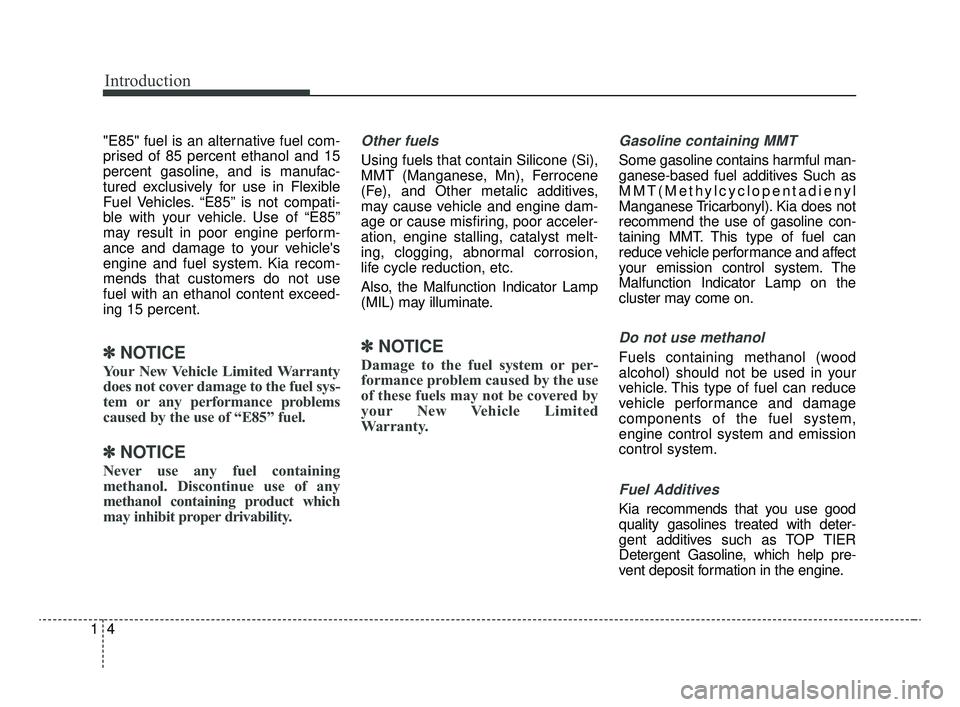
Introduction
41
"E85" fuel is an alternative fuel com-
prised of 85 percent ethanol and 15
percent gasoline, and is manufac-
tured exclusively for use in Flexible
Fuel Vehicles. ŌĆ£E85ŌĆØ is not compati-
ble with your vehicle. Use of ŌĆ£E85ŌĆØ
may result in poor engine perform-
ance and damage to your vehicle's
engine and fuel system. Kia recom-
mends that customers do not use
fuel with an ethanol content exceed-
ing 15 percent.
Ō£Į Ō£Į
NOTICE
Your New Vehicle Limited Warranty
does not cover damage to the fuel sys-
tem or any performance problems
caused by the use of ŌĆ£E85ŌĆØ fuel.
Ō£Į Ō£Į
NOTICE
Never use any fuel containing
methanol. Discontinue use of any
methanol containing product which
may inhibit proper drivability.
Other fuels
Using fuels that contain Silicone (Si),
MMT (Manganese, Mn), Ferrocene
(Fe), and Other metalic additives,
may cause vehicle and engine dam-
age or cause misfiring, poor acceler-
ation, engine stalling, catalyst melt-
ing, clogging, abnormal corrosion,
life cycle reduction, etc.
Also, the Malfunction Indicator Lamp
(MIL) may illuminate.
Ō£Į Ō£Į
NOTICE
Damage to the fuel system or per-
formance problem caused by the use
of these fuels may not be covered by
your New Vehicle Limited
Warranty.
Gasoline containing MMT
Some gasoline contains harmful man-
ganese-based fuel additives Such as
MMT(Methylcyclopentadienyl
Manganese Tricarbonyl). Kia does not
recommend the use of gasoline con-
taining MMT. This type of fuel can
reduce vehicle performance and affect
your emission control system. The
Malfunction Indicator Lamp on the
cluster may come on.
Do not use methanol
Fuels containing methanol (wood
alcohol) should not be used in your
vehicle. This type of fuel can reduce
vehicle performance and damage
components of the fuel system,
engine control system and emission
control system.
Fuel Additives
Kia recommends that you use good
quality gasolines treated with deter-
gent additives such as TOP TIER
Detergent Gasoline, which help pre-
vent deposit formation in the engine.
JFa PE USA 1.qxp 5/17/2019 4:47 PM Page 4
Page 10 of 591
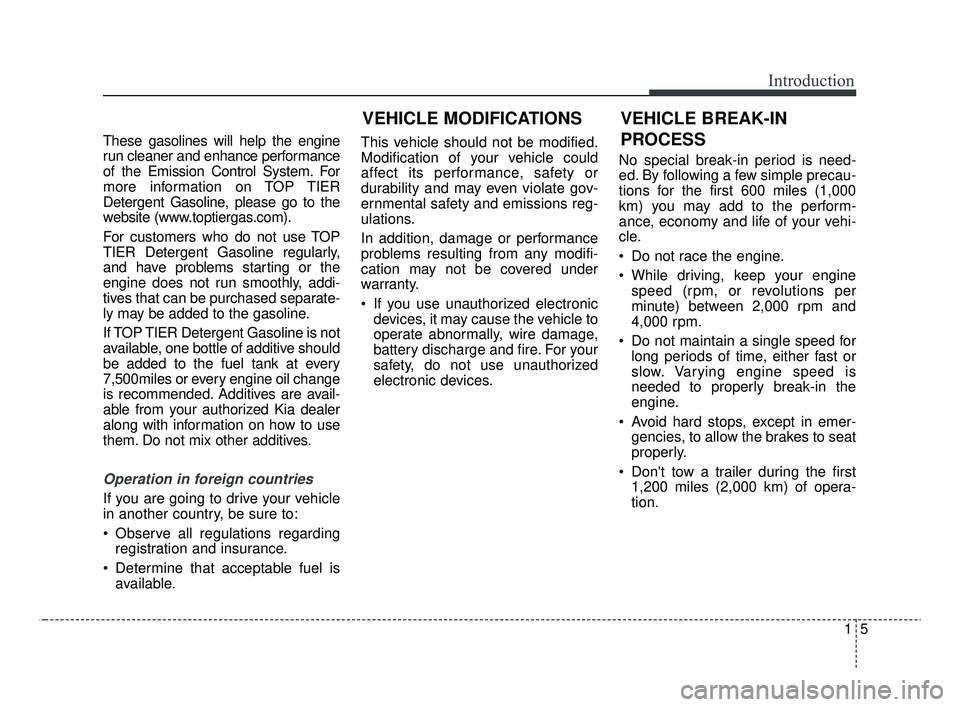
15
Introduction
These gasolines will help the engine
run cleaner and enhance performance
of the Emission Control System. For
more information on TOP TIER
Detergent Gasoline, please go to the
website (www.toptiergas.com).
For customers who do not use TOP
TIER Detergent Gasoline regularly,
and have problems starting or the
engine does not run smoothly, addi-
tives that can be purchased separate-
ly may be added to the gasoline.
If TOP TIER Detergent Gasoline is not
available, one bottle of additive should
be added to the fuel tank at every
7,500miles or every engine oil change
is recommended. Additives are avail-
able from your authorized Kia dealer
along with information on how to use
them. Do not mix other additives.
Operation in foreign countries
If you are going to drive your vehicle
in another country, be sure to:
Observe all regulations regardingregistration and insurance.
Determine that acceptable fuel is available. This vehicle should not be modified.
Modification of your vehicle could
affect its performance, safety or
durability and may even violate gov-
ernmental safety and emissions reg-
ulations.
In addition, damage or performance
problems resulting from any modifi-
cation may not be covered under
warranty.
If you use unauthorized electronic
devices, it may cause the vehicle to
operate abnormally, wire damage,
battery discharge and fire. For your
safety, do not use unauthorized
electronic devices. No special break-in period is need-
ed. By following a few simple precau-
tions for the first 600 miles (1,000
km) you may add to the perform-
ance, economy and life of your vehi-
cle.
Do not race the engine.
While driving, keep your engine
speed (rpm, or revolutions per
minute) between 2,000 rpm and
4,000 rpm.
Do not maintain a single speed for long periods of time, either fast or
slow. Varying engine speed is
needed to properly break-in the
engine.
Avoid hard stops, except in emer- gencies, to allow the brakes to seat
properly.
Don't tow a trailer during the first 1,200 miles (2,000 km) of opera-
tion.
VEHICLE BREAK-IN
PROCESS
VEHICLE MODIFICATIONS
JFa PE USA 1.qxp 5/17/2019 4:47 PM Page 5
Page 14 of 591
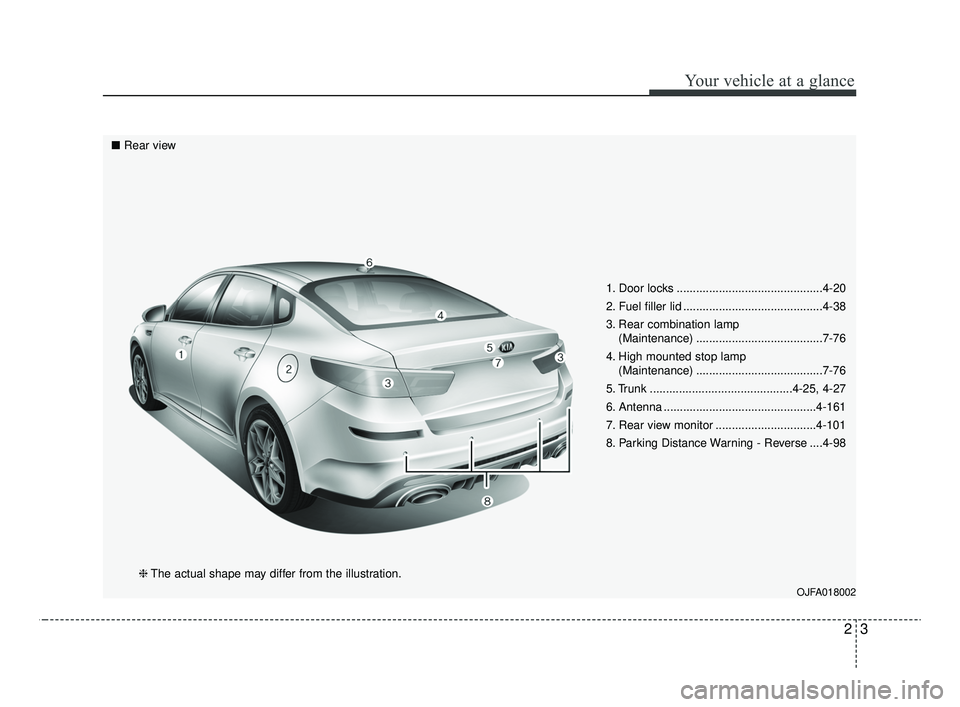
23
Your vehicle at a glance
1. Door locks .............................................4-20
2. Fuel filler lid ...........................................4-38
3. Rear combination lamp(Maintenance) .......................................7-76
4. High mounted stop lamp (Maintenance) .......................................7-76
5. Trunk ............................................4-25, 4-27
6. Antenna ...............................................4-161
7. Rear view monitor ...............................4-101
8. Parking Distance Warning - Reverse ....4-98
OJFA018002
Ō¢Ā Rear view
ŌØłThe actual shape may differ from the illustration.
JFa PE USA 2.QXP 5/15/2019 3:07 PM Page 3
Page 15 of 591
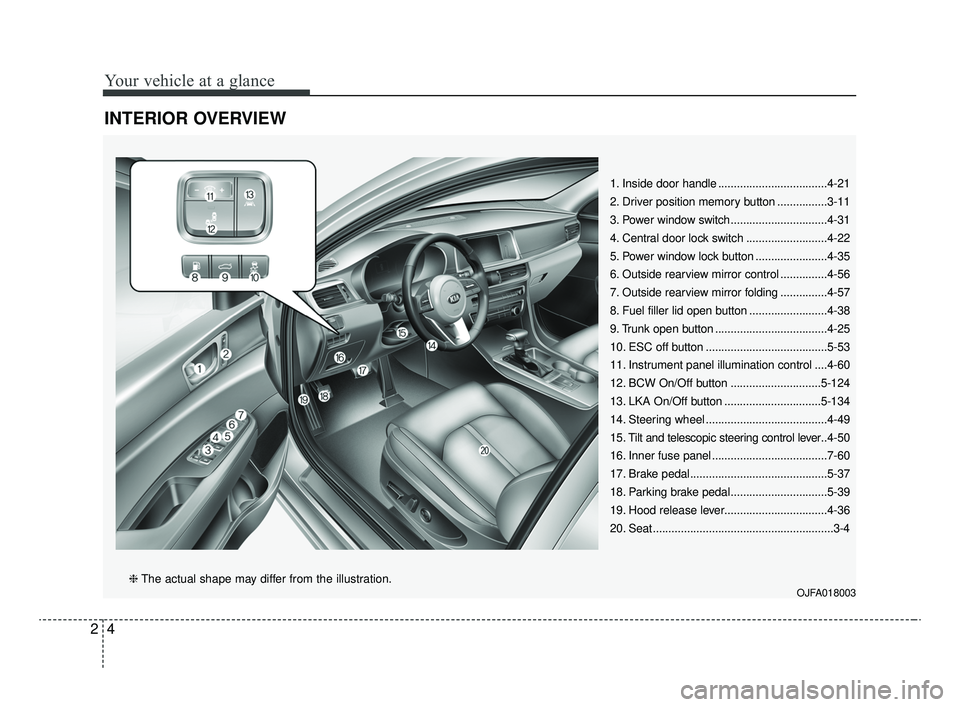
Your vehicle at a glance
42
INTERIOR OVERVIEW
1. Inside door handle ...................................4-21
2. Driver position memory button ................3-11
3. Power window switch...............................4-31
4. Central door lock switch ..........................4-22
5. Power window lock button .......................4-35
6. Outside rearview mirror control ...............4-56
7. Outside rearview mirror folding ...............4-57
8. Fuel filler lid open button .........................4-38
9. Trunk open button ....................................4-25
10. ESC off button .......................................5-53
11. Instrument panel illumination control ....4-60
12. BCW On/Off button .............................5-124
13. LKA On/Off button ...............................5-134
14. Steering wheel .......................................4-49
15. Tilt and telescopic steering control lever..4-50
16. Inner fuse panel .....................................7-60
17. Brake pedal............................................5-37
18. Parking brake pedal...............................5-39
19. Hood release lever.................................4-36
20. Seat..........................................................3-4
OJFA018003ŌØł The actual shape may differ from the illustration.
JFa PE USA 2.QXP 5/15/2019 3:07 PM Page 4
Page 91 of 591
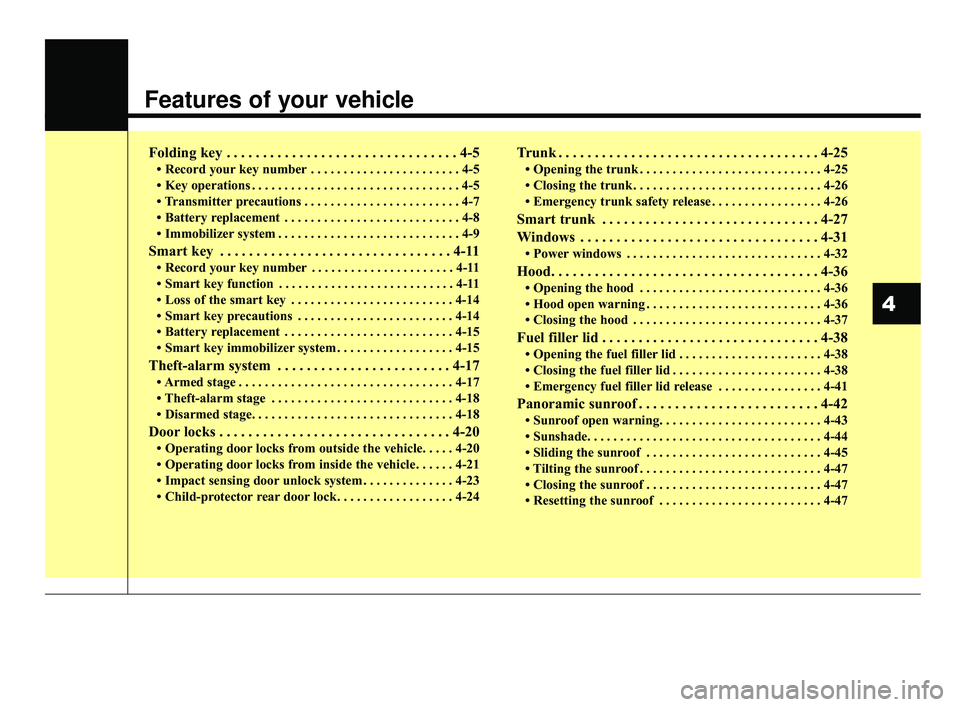
Features of your vehicle
Folding key . . . . . . . . . . . . . . . . . . . . . . . . . . . . . . . . 4-5
ŌĆó Record your key number . . . . . . . . . . . . . . . . . . . . . . . 4-5
ŌĆó Key operations . . . . . . . . . . . . . . . . . . . . . . . . . . . . . . . . 4-5
ŌĆó Transmitter precautions . . . . . . . . . . . . . . . . . . . . . . . . 4-7
ŌĆó Battery replacement . . . . . . . . . . . . . . . . . . . . . . . . . . . 4-8
ŌĆó Immobilizer system . . . . . . . . . . . . . . . . . . . . . . . . . . . . 4-9
Smart key . . . . . . . . . . . . . . . . . . . . . . . . . . . . . . . . 4-11
ŌĆó Record your key number . . . . . . . . . . . . . . . . . . . . . . 4-11
ŌĆó Smart key function . . . . . . . . . . . . . . . . . . . . . . . . . . . 4-11
ŌĆó Loss of the smart key . . . . . . . . . . . . . . . . . . . . . . . . . 4-14
ŌĆó Smart key precautions . . . . . . . . . . . . . . . . . . . . . . . . 4-14
ŌĆó Battery replacement . . . . . . . . . . . . . . . . . . . . . . . . . . 4-15
ŌĆó Smart key immobilizer system . . . . . . . . . . . . . . . . . . 4-15
Theft-alarm system . . . . . . . . . . . . . . . . . . . . . . . . 4-17
ŌĆó Armed stage . . . . . . . . . . . . . . . . . . . . . . . . . . . . . . . . . 4-17
ŌĆó Theft-alarm stage . . . . . . . . . . . . . . . . . . . . . . . . . . . . 4-18
ŌĆó Disarmed stage. . . . . . . . . . . . . . . . . . . . . . . . . . . . . . . 4-18
Door locks . . . . . . . . . . . . . . . . . . . . . . . . . . . . . . . . 4-20
ŌĆó Operating door locks from outside the vehicle. . . . . 4-20
ŌĆó Operating door locks from inside the vehicle . . . . . . 4-21
ŌĆó Impact sensing door unlock system . . . . . . . . . . . . . . 4-23
ŌĆó Child-protector rear door lock. . . . . . . . . . . . . . . . . . 4-24
Trunk . . . . . . . . . . . . . . . . . . . . . . . . . . . . . . . . . . . . \
4-25
ŌĆó Opening the trunk . . . . . . . . . . . . . . . . . . . . . . . . . . . . 4-25
ŌĆó Closing the trunk . . . . . . . . . . . . . . . . . . . . . . . . . . . . . 4-26
ŌĆó Emergency trunk safety release . . . . . . . . . . . . . . . . . 4-26
Smart trunk . . . . . . . . . . . . . . . . . . . . . . . . . . . . . . 4-27
Windows . . . . . . . . . . . . . . . . . . . . . . . . . . . . . . . . . 4-31
ŌĆó Power windows . . . . . . . . . . . . . . . . . . . . . . . . . . . . . . 4-32
Hood. . . . . . . . . . . . . . . . . . . . . . . . . . . . . . . . . . . . \
. 4-36
ŌĆó Opening the hood . . . . . . . . . . . . . . . . . . . . . . . . . . . . 4-36
ŌĆó Hood open warning . . . . . . . . . . . . . . . . . . . . . . . . . . . 4-36
ŌĆó Closing the hood . . . . . . . . . . . . . . . . . . . . . . . . . . . . . 4-37
Fuel filler lid . . . . . . . . . . . . . . . . . . . . . . . . . . . . . . 4-38
ŌĆó Opening the fuel filler lid . . . . . . . . . . . . . . . . . . . . . . 4-38
ŌĆó Closing the fuel filler lid . . . . . . . . . . . . . . . . . . . . . . . 4-38
ŌĆó Emergency fuel filler lid release . . . . . . . . . . . . . . . . 4-41
Panoramic sunroof . . . . . . . . . . . . . . . . . . . . . . . . . 4-42
ŌĆó Sunroof open warning. . . . . . . . . . . . . . . . . . . . . . . . . 4-43
ŌĆó Sunshade. . . . . . . . . . . . . . . . . . . . . . . . . . . . . . . . \
. . . . 4-44
ŌĆó Sliding the sunroof . . . . . . . . . . . . . . . . . . . . . . . . . . . 4-45
ŌĆó Tilting the sunroof . . . . . . . . . . . . . . . . . . . . . . . . . . . . 4-47
ŌĆó Closing the sunroof . . . . . . . . . . . . . . . . . . . . . . . . . . . 4-47
ŌĆó Resetting the sunroof . . . . . . . . . . . . . . . . . . . . . . . . . 4-47
4
JFa PE USA 4.qxp 5/15/2019 3:16 PM Page 1
Page 92 of 591

Steering wheel . . . . . . . . . . . . . . . . . . . . . . . . . . . . . 4-49
ŌĆó Electric Power Steering (EPS) . . . . . . . . . . . . . . . . . . 4-49
ŌĆó Tilt and telescopic steering . . . . . . . . . . . . . . . . . . . . . 4-50
ŌĆó Heated steering wheel . . . . . . . . . . . . . . . . . . . . . . . . . 4-51
ŌĆó Horn . . . . . . . . . . . . . . . . . . . . . . . . . . . . . . . . . . . . \
. . . 4-52
Mirrors . . . . . . . . . . . . . . . . . . . . . . . . . . . . . . . . . . 4-53\
ŌĆó Inside rearview mirror . . . . . . . . . . . . . . . . . . . . . . . . 4-53
ŌĆó Outside rearview mirror. . . . . . . . . . . . . . . . . . . . . . . 4-55
Instrument cluster . . . . . . . . . . . . . . . . . . . . . . . . . 4-59
ŌĆó Instrument cluster control . . . . . . . . . . . . . . . . . . . . . 4-60
ŌĆó LCD display control . . . . . . . . . . . . . . . . . . . . . . . . . . 4-60
ŌĆó Gauges . . . . . . . . . . . . . . . . . . . . . . . . . . . . . . . . . . . . \
. 4-61
ŌĆó Transmission shift indicator . . . . . . . . . . . . . . . . . . . . 4-64
LCD display . . . . . . . . . . . . . . . . . . . . . . . . . . . . . . 4-65
ŌĆó LCD modes. . . . . . . . . . . . . . . . . . . . . . . . . . . . . . . . . . 4-65\
ŌĆó User settings mode. . . . . . . . . . . . . . . . . . . . . . . . . . . . 4-68
Trip modes (Trip computer) . . . . . . . . . . . . . . . . . 4-74
ŌĆó Trip modes . . . . . . . . . . . . . . . . . . . . . . . . . . . . . . . . . . 4-74\
ŌĆó Fuel economy . . . . . . . . . . . . . . . . . . . . . . . . . . . . . . . . 4-75
ŌĆó Warning messages . . . . . . . . . . . . . . . . . . . . . . . . . . . . 4-78
Warning and indicator lights . . . . . . . . . . . . . . . . 4-85
ŌĆó Warning lights . . . . . . . . . . . . . . . . . . . . . . . . . . . . . . . 4-85
ŌĆó Indicator lights. . . . . . . . . . . . . . . . . . . . . . . . . . . . . . . 4-93
Parking Distance Warning-Reverse . . . . . . . . . . . 4-98
ŌĆó Operation of the Parking Distance Warning-Reverse . 4-98
ŌĆó Non-operational conditions of Parking Distance Warning-Reverse . . . . . . . . . . . . . . . . . . . . . . . . . . . . . 4-99
ŌĆó Parking Distance Warning-Reverse precautions . . 4-100
ŌĆó Self-diagnosis . . . . . . . . . . . . . . . . . . . . . . . . . . . . . . . 4-100
Rear view monitor . . . . . . . . . . . . . . . . . . . . . . . . 4-101
Surround view monitor system (SVM) . . . . . . . 4-102
Lighting . . . . . . . . . . . . . . . . . . . . . . . . . . . . . . . . . 4-103
ŌĆó Battery saver function. . . . . . . . . . . . . . . . . . . . . . . . 4-103
ŌĆó Daytime running light . . . . . . . . . . . . . . . . . . . . . . . . 4-103
ŌĆó Lighting control . . . . . . . . . . . . . . . . . . . . . . . . . . . . . 4-103
ŌĆó High beam operation. . . . . . . . . . . . . . . . . . . . . . . . . 4-105
ŌĆó High beam assist . . . . . . . . . . . . . . . . . . . . . . . . . . . . 4-106
ŌĆó Turn signals and lane change signals . . . . . . . . . . . 4-109
ŌĆó Check headlight . . . . . . . . . . . . . . . . . . . . . . . . . . . . . 4-110
ŌĆó Front fog light . . . . . . . . . . . . . . . . . . . . . . . . . . . . . . 4-110
ŌĆó Headlight leveling device. . . . . . . . . . . . . . . . . . . . . . 4-111
ŌĆó Dynamic Bending Light (DBL) . . . . . . . . . . . . . . . . 4-111
Wipers and washers . . . . . . . . . . . . . . . . . . . . . . . 4-113
ŌĆó Windshield wipers . . . . . . . . . . . . . . . . . . . . . . . . . . . 4-113
ŌĆó Front windshield washers . . . . . . . . . . . . . . . . . . . . . 4-114
4
JFa PE USA 4.qxp 5/15/2019 3:16 PM Page 2
Page 128 of 591
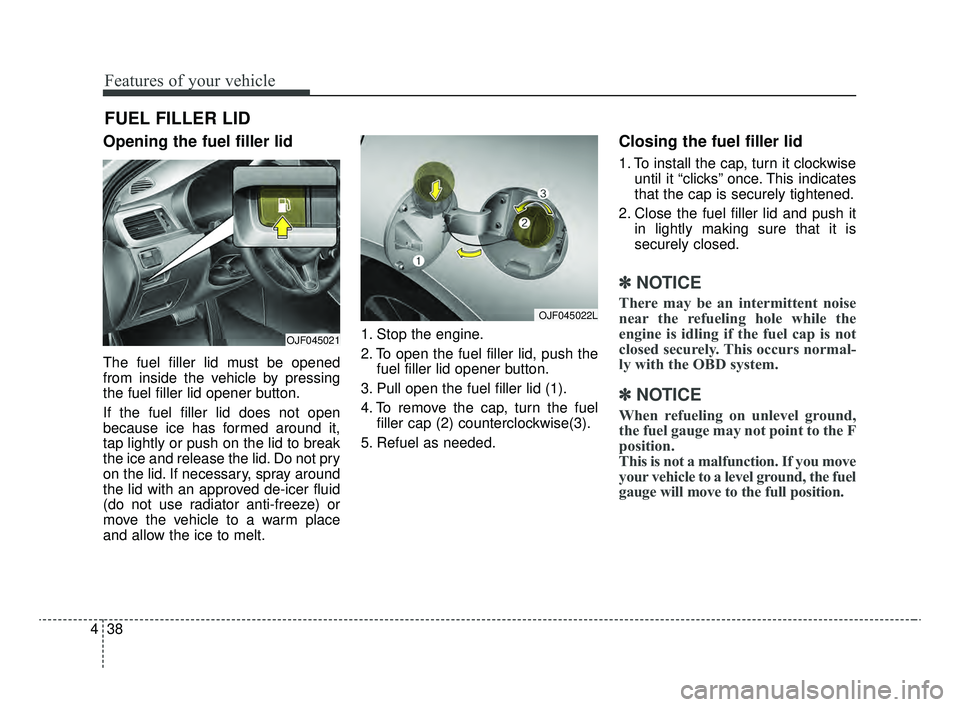
Features of your vehicle
38
4
Opening the fuel filler lid
The fuel filler lid must be opened
from inside the vehicle by pressing
the fuel filler lid opener button.
If the fuel filler lid does not open
because ice has formed around it,
tap lightly or push on the lid to break
the ice and release the lid. Do not pry
on the lid. If necessary, spray around
the lid with an approved de-icer fluid
(do not use radiator anti-freeze) or
move the vehicle to a warm place
and allow the ice to melt. 1. Stop the engine.
2. To open the fuel filler lid, push the
fuel filler lid opener button.
3. Pull open the fuel filler lid (1).
4. To remove the cap, turn the fuel filler cap (2) counterclockwise(3).
5. Refuel as needed.
Closing the fuel filler lid
1. To install the cap, turn it clockwise until it ŌĆ£clicksŌĆØ once. This indicates
that the cap is securely tightened.
2. Close the fuel filler lid and push it in lightly making sure that it is
securely closed.
Ō£Į Ō£ĮNOTICE
There may be an intermittent noise
near the refueling hole while the
engine is idling if the fuel cap is not
closed securely. This occurs normal-
ly with the OBD system.
Ō£Į Ō£ĮNOTICE
When refueling on unlevel ground,
the fuel gauge may not point to the F
position.
This is not a malfunction. If you move
your vehicle to a level ground, the fuel
gauge will move to the full position.
FUEL FILLER LID
OJF045021
OJF045022L
JFa PE USA 4.qxp 5/15/2019 3:18 PM Page 38
Page 129 of 591
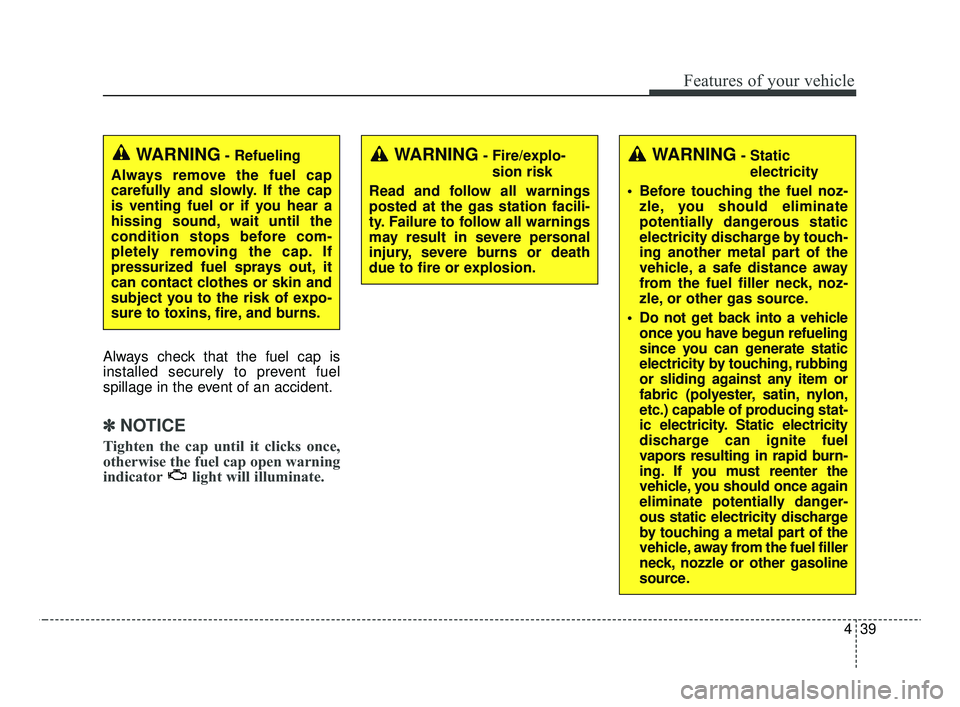
439
Features of your vehicle
Always check that the fuel cap is
installed securely to prevent fuel
spillage in the event of an accident.
Ō£Į Ō£ĮNOTICE
Tighten the cap until it clicks once,
otherwise the fuel cap open warning
indicator light will illuminate.
WARNING- Fire/explo-
sion risk
Read and follow all warnings
posted at the gas station facili-
ty. Failure to follow all warnings
may result in severe personal
injury, severe burns or death
due to fire or explosion.WARNING- Static electricity
Before touching the fuel noz- zle, you should eliminate
potentially dangerous static
electricity discharge by touch-
ing another metal part of the
vehicle, a safe distance away
from the fuel filler neck, noz-
zle, or other gas source.
Do not get back into a vehicle once you have begun refueling
since you can generate static
electricity by touching, rubbing
or sliding against any item or
fabric (polyester, satin, nylon,
etc.) capable of producing stat-
ic electricity. Static electricity
discharge can ignite fuel
vapors resulting in rapid burn-
ing. If you must reenter the
vehicle, you should once again
eliminate potentially danger-
ous static electricity discharge
by touching a metal part of the
vehicle, away from the fuel filler
neck, nozzle or other gasoline
source.WARNING- Refueling
Always remove the fuel cap
carefully and slowly. If the cap
is venting fuel or if you hear a
hissing sound, wait until the
condition stops before com-
pletely removing the cap. If
pressurized fuel sprays out, it
can contact clothes or skin and
subject you to the risk of expo-
sure to toxins, fire, and burns.
JFa PE USA 4.qxp 5/15/2019 3:18 PM Page 39